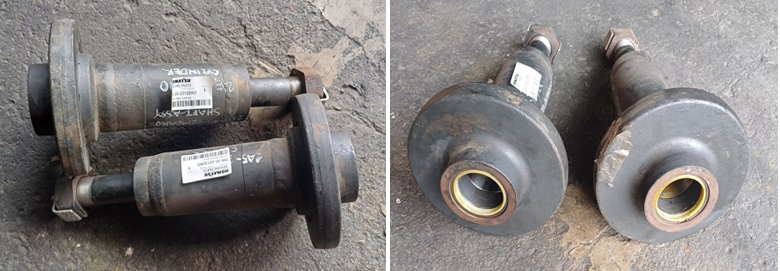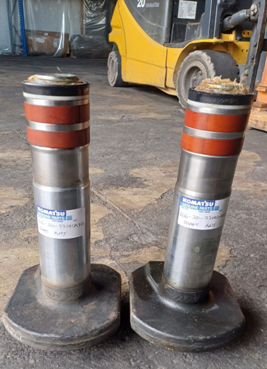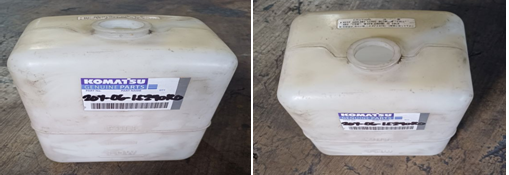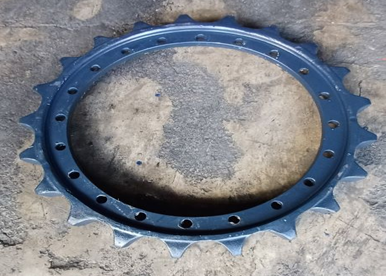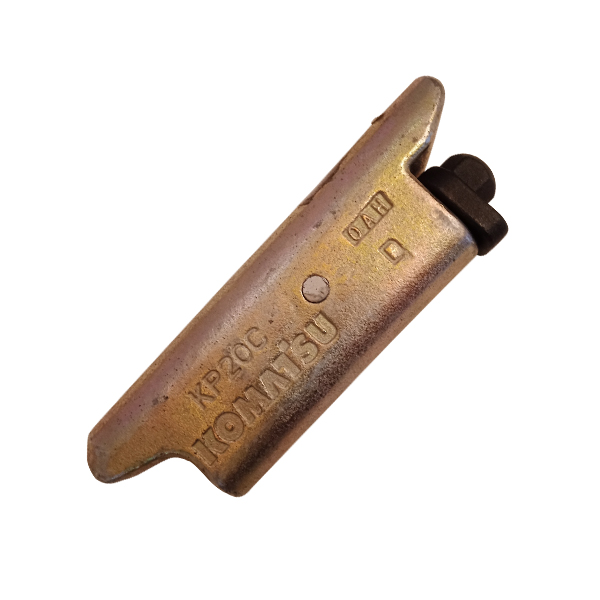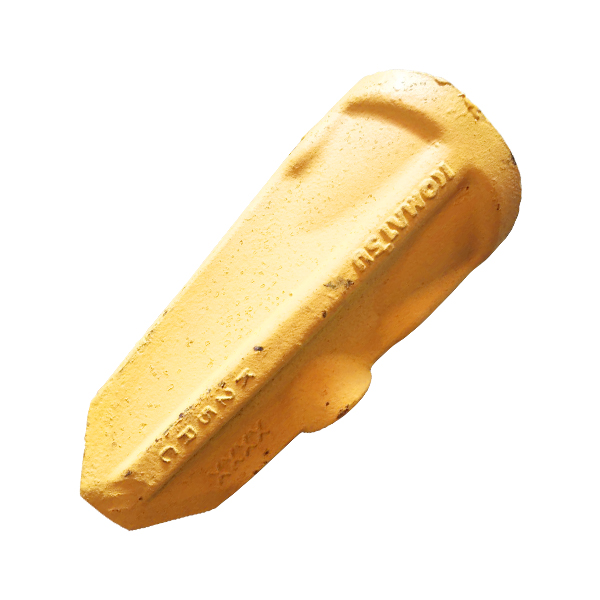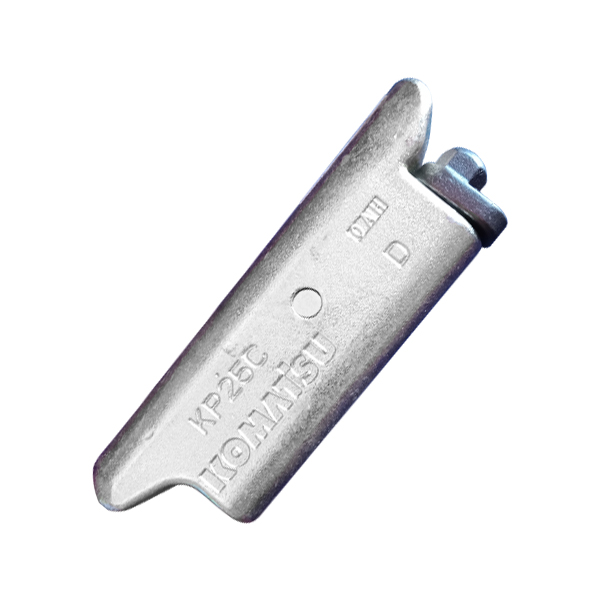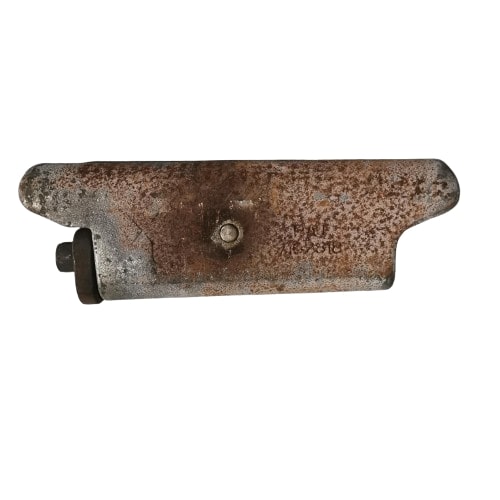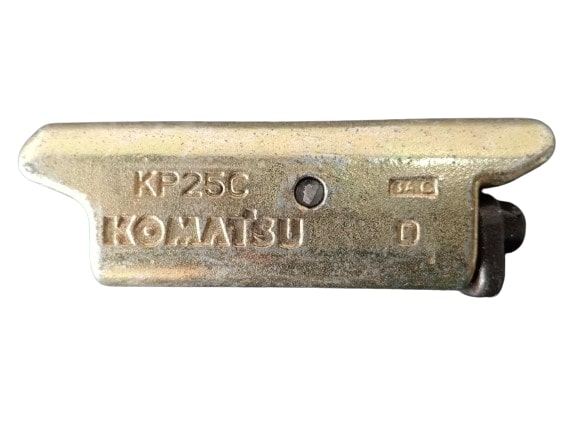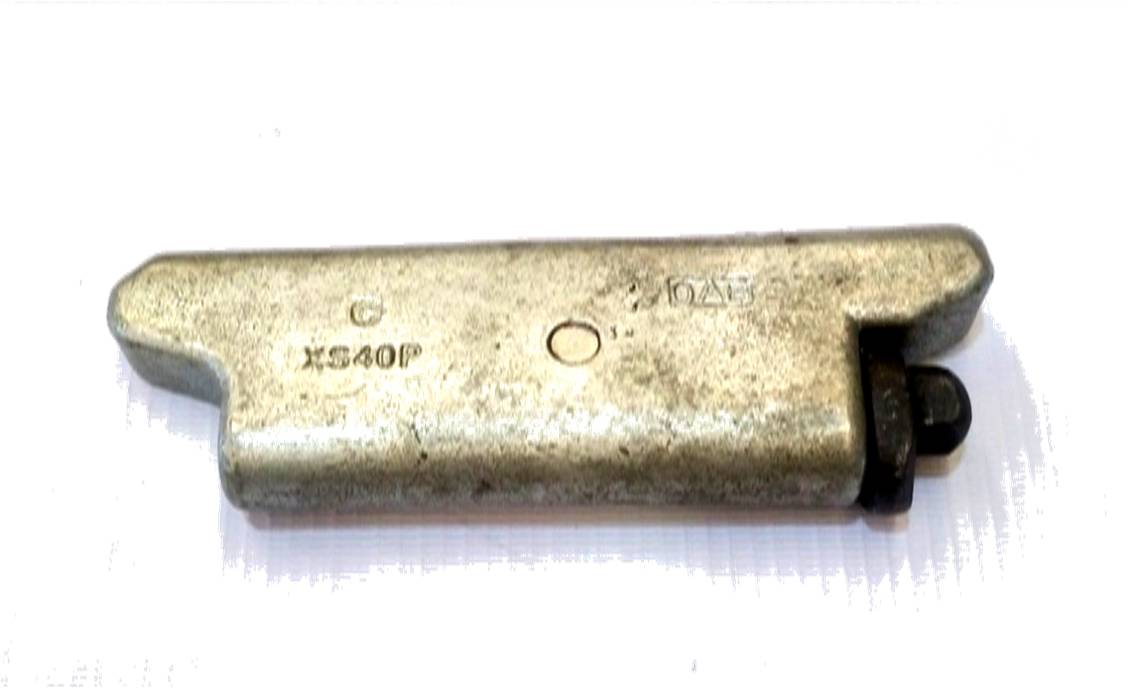43,600.00 PHP
SKU: 206-30-22120VP
UOM: Piece
Stock: 2
Dismantled parts from PC200LC-8M0 C15621.
The Idler Cushion Cylinder of the Komatsu PC200LC-8M0 is a critical component in the excavator’s undercarriage system, specifically responsible for maintaining proper track tension and absorbing shocks. Its primary function is to control the movement and alignment of the idler wheel, ensuring that the tracks remain tight, aligned, and able to perform effectively under various operational conditions. Here is a detailed breakdown of the Idler Cushion Cylinder:
1. Function and Purpose:
- The Idler Cushion Cylinder ensures that the tracks of the excavator are always properly tensioned. Proper track tension is critical for smooth movement and the overall efficiency of the excavator.
- It acts as a shock absorber, dampening impacts and vibrations that occur when the excavator moves over rough or uneven terrain. This function helps protect the undercarriage components, including the idler, rollers, and tracks, from excessive wear.
- By adjusting the tension automatically, the idler cushion cylinder prevents track slippage, derailment, and damage to the track system.
2. Components of the Idler Cushion Cylinder:
The cylinder itself is a hydraulic component with the following key parts:
- Hydraulic Cylinder: The main body of the cushion cylinder, which houses the piston and hydraulic fluid.
- Piston: Moves within the cylinder to adjust the tension. As hydraulic pressure is applied, the piston extends or retracts, moving the idler wheel to tighten or loosen the tracks.
- Rod: Connected to the piston, it extends and retracts based on the piston’s movement, pushing against the idler wheel to maintain track tension.
- Hydraulic Fluid: The cylinder is part of the excavator’s hydraulic system, using pressurized fluid to power the movement of the piston.
- Seals and O-Rings: These prevent hydraulic fluid from leaking out and keep contaminants like dirt and moisture from entering the hydraulic system.
- Ports for Hydraulic Connections: These connect the cylinder to the excavator’s hydraulic system, allowing fluid to flow into and out of the cylinder.
3. Operation:
- The Idler Cushion Cylinder operates through the excavator’s hydraulic system. When pressure is applied by the hydraulic system, the piston inside the cylinder moves, which extends or retracts the rod attached to the idler wheel.
- This action adjusts the position of the idler wheel, tightening or loosening the tracks depending on the operating conditions.
- In addition to maintaining track tension, the idler cushion cylinder absorbs shocks when the machine moves over rough ground or hits obstacles, thereby reducing the stress on other undercarriage components.
4. Material and Construction:
- The hydraulic cylinder is made of hardened steel or other durable metals that can withstand high pressures and rough working conditions.
- Seals and O-rings are typically made from heavy-duty rubber or synthetic materials, capable of enduring hydraulic pressure while keeping out dirt and debris.
5. Role in Track Tension:
- Maintaining proper track tension is crucial to preventing track slippage, misalignment, and premature wear of undercarriage components.
- If the tracks become too loose, the cylinder automatically adjusts by pushing the idler wheel outward to tighten the tracks.
- If the tracks are too tight, the cylinder retracts, pulling the idler wheel back and relieving the excess tension.
6. Shock Absorption:
- The shock absorption function of the idler cushion cylinder is essential for reducing wear on the undercarriage. When the excavator moves over uneven surfaces, the cylinder compresses slightly, absorbing the impact that would otherwise be transferred to the tracks and rollers.
7. Maintenance:
- Regular maintenance of the idler cushion cylinder is essential to ensure smooth operation and longevity. This includes:
- Inspecting for hydraulic leaks: Any sign of hydraulic fluid leaking from the cylinder should be addressed immediately.
- Checking the seals and gaskets: These components prevent fluid loss and keep dirt out. If they become worn, they should be replaced.
- Lubrication: Proper lubrication of the rod and other moving parts ensures smooth operation and reduces wear.
- Hydraulic fluid level checks: Low fluid levels can affect the cylinder's performance and should be monitored regularly.
8. Common Issues:
- Hydraulic Leaks: A common issue in the idler cushion cylinder is the leakage of hydraulic fluid due to worn seals, gaskets, or connections.
- Seized Piston or Rod: If not properly lubricated or maintained, the piston or rod may become stuck, preventing the cylinder from adjusting track tension.
- Corrosion: Exposure to moisture or harsh environmental conditions can lead to corrosion on the cylinder’s body, reducing its effectiveness and lifespan.
9. Importance of Proper Operation:
- If the idler cushion cylinder is not functioning properly, the tracks can become misaligned or too loose, causing:
- Premature wear on the track components, rollers, and idler wheels.
- Track derailment, leading to operational downtime.
- Reduced efficiency of the excavator, especially during heavy-duty or rough-terrain work.
- Therefore, ensuring that the idler cushion cylinder is in good working condition is crucial for minimizing operational delays and maximizing the excavator's productivity.
10. Durability and Protection:
- The cylinder is designed for heavy-duty use and built to handle the constant stresses of excavation, including dirt, debris, and environmental challenges.
- To extend the lifespan of the idler cushion cylinder, regular maintenance and protection from excessive dirt and debris are recommended.
Summary:
The Idler Cushion Cylinder of the Komatsu PC200LC-8M0 is a vital hydraulic component responsible for maintaining proper track tension and absorbing shocks. By adjusting the position of the idler wheel, it ensures that the tracks remain properly aligned and tensioned, which is critical for the excavator's stability and performance. The cylinder also cushions the impact of rough terrain, protecting the undercarriage components from excessive wear. Regular inspection, lubrication, and maintenance of the cylinder, seals, and hydraulic connections are essential for ensuring its reliable operation and prolonging the excavator's overall lifespan.
|
4,729.06 PHP
SKU: YM119005-12571
UOM: Piece
Stock: 1
|
2,689.53 PHP
SKU: YM129917-55850
UOM: Piece
Stock: 7
|
2,552.86 PHP
SKU: HLKP20C
UOM: Piece
Stock: 105
|
17,100.00 PHP
SKU: 206-30-72140VP
UOM: Piece
Stock: 2
Dismantled parts from PC200LC-8M0 C15621.
The Shaft Assembly of the Recoil Spring Assembly on a Komatsu PC200LC-8M0 hydraulic excavator is a critical component within the track adjuster system. Its primary function is to support the tensioning mechanism of the track, which helps maintain proper track tension during operation and prevents excessive wear or derailment of the track links.
Key Components of the Shaft Assembly in Recoil Spring Assembly:
-
Guide Shaft: A central shaft that runs through the recoil spring. It serves as the main support structure, ensuring the spring compresses and decompresses smoothly. This shaft guides the movement of the spring and maintains alignment.
-
Seal and Bushing: These ensure the smooth movement of the guide shaft and protect against contaminants like dust and dirt, ensuring longer life and reliable operation.
Function:
- The shaft assembly ensures that the recoil spring functions correctly by maintaining alignment and controlling the spring’s compression and expansion.
- It absorbs impact forces transmitted through the undercarriage during operation, especially when moving over rough terrain, ensuring smoother operation and extending the service life of the undercarriage components.
In summary, the shaft assembly of the recoil spring assembly is essential for maintaining track tension and ensuring the smooth operation of the Komatsu PC200LC-8M0's undercarriage.
4o
|
600.99 PHP
SKU: YM119802-55710
UOM: Piece
Stock: 0
|
1,478.32 PHP
SKU: YM129930-42480
UOM: Piece
Stock: 1
|
7,389.17 PHP
SKU: HLK25RC
UOM: Piece
Stock: 108
|
3,980.55 PHP
SKU: 20Y-06-15240VP
UOM: Piece
Stock: 1
Dismantled parts from PC200LC-8M0 C15621.
The Window Washer Tank on a Komatsu PC200LC-8M0 is a component of the windshield cleaning system, designed to store and supply cleaning fluid for the excavator’s windshield washer system. It ensures clear visibility for the operator, particularly in dusty, muddy, or wet working conditions.
Key Features and Functions:
1. Storage for Washer Fluid:
- The washer tank holds the windshield washer fluid, typically a mixture of water and cleaning agents. This fluid helps to clean the excavator’s front windshield and, in some models, side windows if applicable.
2. Positioning:
- The washer tank is usually located in the cab or under the hood, accessible for easy refilling. Its positioning allows convenient access for routine maintenance and ensures the operator has a clear view of the operating area.
3. Pump System:
- The washer tank is connected to a pump that draws the cleaning fluid from the tank and sprays it onto the windshield through nozzles. The system is activated by controls within the operator's cabin.
4. Importance for Visibility and Safety:
- Keeping the windows clean is essential for maintaining optimal visibility, especially in construction or mining environments where dust, dirt, or rain can accumulate on the windshield. Clear visibility is crucial for operator safety and for precise operation of the machine.
5. Maintenance and Refill:
- The washer tank needs regular checking and refilling to ensure it contains enough fluid to perform the cleaning function. It is typically made of a durable, non-corrosive plastic material and has a clear or semi-transparent design to easily check fluid levels.
In Summary:
The Window Washer Tank of the Komatsu PC200LC-8M0 stores and supplies cleaning fluid for the windshield washer system, ensuring the operator has clear visibility for safe and efficient operation. It's a critical part of the machine's maintenance to ensure optimal working conditions, especially in harsh environments.
|
1,484.71 PHP
SKU: YM119802-55801
UOM: Piece
Stock: 12
|
13,616.78 PHP
SKU: HLSCB220SO
UOM: Piece
Stock: 26
|
5,584.55 PHP
SKU: HLK20SYL
UOM: Piece
Stock: 65
|
6,739.81 PHP
SKU: 20Y-27-77110VP
UOM: Piece
Stock: 1
Dismantled parts from PC200LC-8M0 C15621.
The sprocket of the Komatsu PC200LC-8M0 is a vital component of the excavator’s undercarriage, responsible for driving the tracks. It plays a central role in transferring power from the final drive motor to the track system, enabling the excavator to move. Below is a detailed description of the sprocket:
1. Material:
- The sprocket is typically made from high-strength, heat-treated steel to ensure durability and resistance to wear. It is designed to withstand the constant friction and heavy loads imposed during excavator operation.
2. Design Features:
- Teeth:
- The sprocket features a series of evenly spaced, hardened teeth that mesh with the track chain links. These teeth are specifically shaped to ensure a tight fit with the track links, enabling smooth propulsion.
- The teeth are designed to minimize wear on both the sprocket and the track chain, contributing to longer service life.
- Circular Structure:
- The sprocket is circular and rotates around a fixed axis. Its design ensures that all teeth engage with the track links at the correct angle, distributing the load evenly and preventing excessive wear.
- Mounting Holes:
- The sprocket has multiple mounting holes that allow it to be bolted securely to the final drive hub. These holes ensure a tight, stable fit and prevent movement during operation.
3. Functionality:
- Track Propulsion:
- As the sprocket rotates, its teeth engage with the track chain links, pulling the track in either a forward or reverse direction. This engagement ensures the excavator’s movement and ability to navigate various terrains.
- Load Distribution:
- The sprocket’s design ensures that the load and stress are evenly distributed across all teeth. This helps prevent localized wear, which could otherwise lead to damage or misalignment of the undercarriage components.
4. Durability and Wear:
- Heat Treatment:
- The sprocket is heat-treated to enhance its hardness and wear resistance. This process ensures that the sprocket can endure continuous contact with the track chain links without suffering significant damage.
- Corrosion Resistance:
- The material is often treated or coated to resist corrosion, which is essential when the machine operates in harsh environments, such as in mud, water, or abrasive soils.
- Wear Pattern:
- Over time, the sprocket teeth will gradually wear down due to constant friction with the track links. Regular inspections are necessary to monitor wear levels and prevent operational issues.
5. Maintenance:
- Inspection:
- Regular inspection of the sprocket is critical to detect signs of wear or damage, such as worn or broken teeth. Uneven wear on the sprocket teeth can indicate misalignment of the track system or improper track tension.
- Replacement:
- If the sprocket teeth become excessively worn or damaged, the sprocket must be replaced to prevent damage to the track chain and other undercarriage components.
6. Importance in the Undercarriage System:
- The sprocket is a core component that works in tandem with other parts of the undercarriage, such as the track rollers, idlers, and track chains. Together, they form a system that allows the Komatsu PC200LC-8M0 to operate efficiently on a wide range of terrains.
- Proper maintenance of the sprocket is crucial for the overall performance and longevity of the undercarriage system. If neglected, a worn sprocket can lead to reduced track engagement, slippage, and damage to other components.
In summary, the sprocket of the Komatsu PC200LC-8M0 is designed for durability and precision, ensuring the efficient movement of the excavator’s tracks. Its proper maintenance and timely replacement are essential for keeping the undercarriage in optimal working condition.
|
1,854.26 PHP
SKU: YM129052-55630
UOM: Piece
Stock: 6
|
2,957.88 PHP
SKU: HLKP25D
UOM: Piece
Stock: 66
|
15,274.48 PHP
SKU: HLXS145PC
UOM: Piece
Stock: 0
|
16,600.00 PHP
SKU: 20Y-30-42110VP
UOM: Piece
Stock: 2
Dismantled parts from PC200LC-8M0 C15621.
The Idler Cushion Yoke of the Komatsu PC200LC-8M0 is a key component of the excavator’s undercarriage system, specifically designed to support the idler wheel and contribute to the proper tensioning and alignment of the track. Here's a detailed breakdown of its role and features:
1. Support for the Idler Wheel:
- The idler wheel is located at the front of the excavator's undercarriage and plays a critical role in guiding the track chain. The idler cushion yoke provides structural support for the idler wheel, holding it in place and ensuring proper alignment with the rest of the track system.
- The idler works with the sprocket, track rollers, and carrier rollers to maintain the correct tension on the track and ensure smooth track movement.
2. Absorption of Shock and Impact:
- The cushion yoke is designed to absorb the shock and impact that the idler experiences when the excavator moves over rough or uneven terrain. This helps protect the idler wheel and other components of the undercarriage from excessive wear or damage.
- By cushioning the impact, it reduces stress on the track chain, contributing to a longer service life for both the track and the undercarriage components.
3. Track Tensioning Function:
- The Idler Cushion Yoke works in conjunction with the excavator’s track tensioning system. It ensures that the idler can move slightly to adjust the track tension as needed. Maintaining the correct tension is crucial to preventing track slippage and excessive wear.
- The yoke allows the idler to adjust its position dynamically, keeping the track properly tensioned while compensating for expansion and contraction caused by changes in temperature, track wear, or debris buildup.
4. Durable Construction:
- The yoke is built from durable, high-strength materials, usually hardened steel, to withstand the heavy-duty conditions the excavator operates in. It must handle the constant forces exerted by the idler and the entire track system while maintaining the flexibility to adjust to changing conditions.
5. Alignment and Stability:
- One of the yoke’s functions is to ensure the proper alignment of the idler wheel, which is essential for track stability. If the idler is misaligned, it could lead to uneven track wear or derailment of the track, which could significantly affect the machine's performance.
- The Idler Cushion Yoke plays a key role in ensuring that the idler moves in a controlled and guided manner, preventing the track from shifting off its path.
6. Maintenance Considerations:
- While the idler cushion yoke is designed to be highly durable, it is subject to wear over time due to the constant forces it experiences. Regular inspections of the yoke are necessary to ensure it remains in good condition.
- Any signs of wear or damage should be addressed promptly to prevent further damage to the undercarriage system.
In Summary:
The Idler Cushion Yoke of the Komatsu PC200LC-8M0 is a critical part of the undercarriage that supports the idler wheel, absorbs shocks, maintains track tension, and ensures proper alignment of the track system. Its role in cushioning impacts and adjusting to tension changes contributes to the overall efficiency, durability, and performance of the excavator’s track system, making it essential for smooth and stable machine operation.
|
2,190.84 PHP
SKU: YM129907-55801
UOM: Piece
Stock: 0
|
2,957.88 PHP
SKU: HLKP25C
UOM: Piece
Stock: 77
|
4,578.90 PHP
SKU: HLXS40PC
UOM: Piece
Stock: 0
|
15,229.57 PHP
SKU: 1507021346
UOM: Piece
Stock: 0
|
|
|
|
